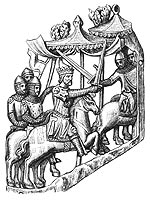

Medieval Warfare, 1000-1300

Despite the smug disapproval that many an academic true believer evinces whenever military history is mentioned, the study of warfare in all of its aspects has grown from exponentially from the small niche of battle or campaign history occupied by such great nineteenth-century authorities as Edward Creasy and Charles Oman. According to John France, the editor of this massive collection on European war between 1000 and 1300, military history in the twenty- first century “is evolving very rapidly indeed.” The twenty-one articles in this collection (a volume in Ashgate’s International Library of Essays on Military History) are drawn from journals such as American Historical Review, Anglo-Norman Studies, Journal of British Studies, Journal of Medieval History, Mediterranean Historical Review, Past and Present, Transactions of the Royal Historical Society, and Viator as well as from a number of essay collections. This collection of articles represents the work of luminaries in the field of military history for the past quarter-century. Though the editor does not formally classify the essays, they can be divided into a number of general classes.
One of the largest of these divisions focuses on the principal warrior of the age, the medieval knight. In seminal works by Matthew Bennett, Stephen Brown, and Michael Prestwick, knightly lives are stripped of the often-unrealistic patina of chivalry and laid bare before their contemporary environment. A great number of articles in this volume deal with ancillary aspects of warmaking. These include John Prestwick’s treatment of army financing in the Anglo-Norman state, R.H.C. Davis’s and Richard Pryor’s assessment of the care and transport of war horses in Continental and Middle Eastern campaigns, Ian Pierce’s discussion of northern European armor prior to the First Crusade; and Malcolm Barber and John Nesbitt’s assessment of supply and rate-of-march among crusader forces. The effect of war on the warriors themselves and the civilian populations they often cruelly oppressed is dealt with in David Nicolle’s study of the medical treatment of soldiers during major crusading campaigns and Yvonne Friedman’s discussion of the capture and ransoming of women during military expeditions of the High Middle Ages.
A large number of the articles included in this collection deal in great detail with the immediate landscape of battle as well the psychological background of commanders and soldiers which combined courage and experience in a primal drive to gain victory. The principal architectural element of medieval warfare in both northern Europe and in the Latin East, the castle, is the subject of articles by Bernard Bachrach, Charles Coulson, Ronnie Ellenblum, and Denys Pringle. The prime weapon utilized against castle walls of the Middle Ages, the trebuchet, is the subject of a seminal article by Donald Hill. The assessment of campaigns and the strategy that directed them comprise a sizeable portion of the articles gathered in this collection. John Beeler’s work on medieval English generalship and John Gillingham’s discussion of science of war under Richard II head this list but are joined by thorough analyses of campaigns in Liege, Toulouse, Spain, and the Latin East by Claude Gaier, Richard Benjamin, Elena Laurie, Alan Murray, A.J. Forey, and John France, respectively. Battle history is also fully represented in this collection with the articles of R. Allen Brown and Stephen Morillo on Hastings, Reuven Amitai-Preiss on Ayn-Jâlût, Thomas Asbridge on the Field of Blood, and Jean Richard on Hattin.
The editor of this collection, John France, has done a fine job in his selection of articles and has thus produced a useful volume for military historian and medievalist alike. From a cursory glance at the subjects of these articles, however, the historical neophyte would assume that the Middle Ages existed only in the French and English realms and among their colonies of the Latin East. Not covered at all or only lightly touched are the rich military traditions of Spain, Italy, and Eastern Europe. If limited space in this very large book is the problem, the publisher should consider a second volume for the military history of the “other Europe.” For their part, scholars of warfare in the Middle Ages would be well served in adapting this broader view of military history for their researches.
